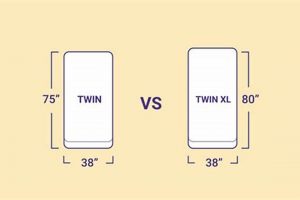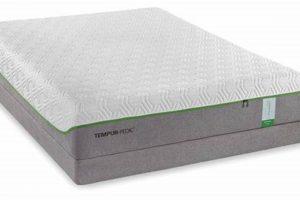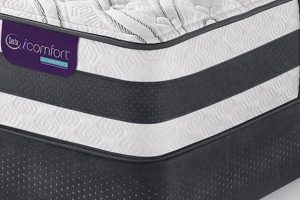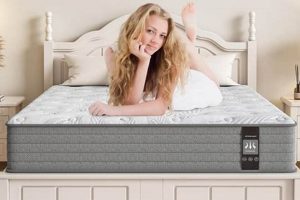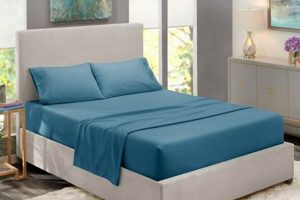An extra-long king-size bed offers additional length compared to a standard king, catering to individuals who require more legroom. This specific bedding configuration generally measures 80 inches in width and 84 inches in length. For instance, a taller individual, typically exceeding six feet in height, may find this option provides more comfortable sleep than standard sizes.
The advantage of this bed configuration lies primarily in its suitability for taller individuals, preventing their feet from hanging off the end. This leads to improved sleep quality, reduced pressure points, and enhanced overall comfort. Historically, standardized mattress sizes were introduced to streamline manufacturing and distribution; however, the need for longer beds grew with increasing average heights in populations.
The subsequent sections will address key factors in choosing the optimal mattress of this dimension, including materials, construction, and suitability for specific sleeping preferences, as well as associated bedding considerations.
Considerations for Extra-Long King Mattresses
Selecting the correct extra-long king mattress necessitates careful assessment. Dimensions, materials, and support characteristics are critical factors.
Tip 1: Measure Bedroom Dimensions: Prior to purchase, accurately measure the bedroom’s floor space. This ensures that the mattress fits comfortably without obstructing movement. Note that the standard width of this configuration is 80 inches; the extra length demands even greater spatial awareness.
Tip 2: Evaluate Material Composition: Investigate the materials used in the mattress construction. Options include memory foam, innerspring, latex, and hybrid models. Memory foam conforms to the body, while innerspring offers firmer support. Latex is known for its durability and breathability.
Tip 3: Determine Preferred Firmness Level: Consider the preferred firmness level. Individuals who sleep on their side typically require a softer mattress to alleviate pressure on the shoulders and hips. Back sleepers often benefit from a medium-firm mattress, while stomach sleepers may need a firmer surface.
Tip 4: Assess Support System: Examine the mattress’s support system. Innerspring mattresses should have a robust coil system to prevent sagging. Memory foam and latex mattresses should have a dense core for adequate support.
Tip 5: Consider Sleeping Position: The individual’s primary sleeping position is critical to mattress selection. Side sleepers often prefer conforming surfaces, while back and stomach sleepers usually require firmer support.
Tip 6: Check Warranty and Trial Period: Examine the warranty and trial period offered by the manufacturer. A longer warranty indicates confidence in the product’s durability. A trial period allows the individual to test the mattress’s suitability.
Tip 7: Factor in Bedding Requirements: Recognize the need for specific bedding to accommodate the dimensions of the mattress. Standard king-size sheets will be too short, and appropriately sized sheets must be acquired. This includes sheets, blankets, and comforters.
Choosing the correct extra-long king mattress requires careful assessment of individual needs and mattress specifications. Paying attention to dimensions, materials, and support features facilitates informed decision-making.
The following section provides insight into maintaining and extending the lifespan of this specific mattress type.
1. Dimensions
The dimensions of an extra-long king mattress directly influence its suitability and effectiveness. A standard king mattress, while wide, may not provide sufficient length for individuals exceeding a certain height threshold. The increased length of the extra-long king, typically 84 inches, directly addresses this limitation. A cause-and-effect relationship is evident: inadequate mattress length causes discomfort and disrupted sleep, whereas appropriate length mitigates these issues. For example, an individual who is 6’4″ sleeping on a standard king mattress (typically 80 inches) may experience discomfort as their feet extend beyond the mattress edge. The extra-long king mattress aims to remedy this.
Understanding the precise dimensions is practically significant when considering bedroom layout and furniture placement. The added length requires more floor space; therefore, measuring the room prior to purchase is crucial. In addition, the increased dimensions impact bedding requirements. Standard king-size sheets will not adequately fit the extra-long king; specialized sheets of the appropriate dimensions must be acquired to ensure a proper fit and maintain hygiene. Furthermore, weight distribution across the mattress changes with the extended length, potentially impacting the lifespan and structural integrity of certain mattress constructions.
In summary, the dimensions are not merely a specification but a defining characteristic of the extra-long king mattress, dictating its target demographic and practical implications. Failure to consider the dimensional aspects can result in a mismatch between user needs and product capabilities, negating the intended benefits. Selecting the correct size ensures optimal comfort and adequate support, essential for restorative sleep.
2. Materials
The materials utilized in the construction of an extra-long king mattress directly influence its performance characteristics, longevity, and suitability for individual needs. Material selection dictates comfort, support, temperature regulation, and resistance to wear and tear.
- Foam Density and Type
Foam density, typically measured in pounds per cubic foot, determines the support and durability of memory foam and polyfoam components. Higher density foams offer increased resistance to compression and sagging, extending the mattress’s lifespan. Examples include high-density memory foam for pressure relief and high-resilience polyfoam for support cores. The selection affects the mattress’s contouring ability and long-term structural integrity in the context of an extra-long king mattress.
- Coil System Gauge and Configuration
For innerspring or hybrid mattresses, the coil system’s gauge and configuration impact support and motion isolation. Lower gauge coils (thicker wires) provide firmer support, while higher gauge coils offer more conforming comfort. Configurations like pocketed coils minimize motion transfer. A robust coil system is particularly important in an extra-long king mattress due to the increased surface area and potential for uneven weight distribution.
- Cover Fabric Properties
The cover fabric’s properties, such as breathability and moisture-wicking capabilities, influence temperature regulation and hygiene. Materials like organic cotton, bamboo, or specialized performance fabrics promote airflow and reduce heat retention. In an extra-long king mattress, the larger surface area amplifies the importance of a breathable cover for preventing overheating and maintaining a comfortable sleep environment.
- Latex Composition and Production Method
Latex, either natural or synthetic, offers a resilient and durable alternative to traditional foams. Natural latex, sourced from rubber trees, exhibits superior breathability and responsiveness. Dunlop latex is denser and firmer, while Talalay latex is softer and more conforming. The specific composition and production method directly impact the comfort and support characteristics of a latex extra-long king mattress, as well as its environmental impact.
The interplay of these materials determines the overall performance of the extra-long king mattress. By carefully considering foam density, coil system properties, cover fabric characteristics, and latex composition, one can select a mattress that aligns with individual comfort preferences, support needs, and long-term durability expectations. The correct material selection enhances sleep quality and the overall value of the investment.
3. Support
The term “support” in the context of an extra-long king mattress refers to the mattress’s ability to maintain spinal alignment and distribute body weight evenly. Adequate support is crucial for preventing pressure points, minimizing back pain, and promoting restful sleep. Given the larger surface area and potential for two individuals to share the bed, the support system is a critical consideration.
- Core Construction and Weight Distribution
The core construction, typically involving innerspring coils, foam layers, or a combination thereof, dictates the mattress’s capacity to distribute weight. A robust core prevents sagging and ensures consistent support across the entire surface. For example, a pocketed coil system allows individual coils to contour to the body, reducing motion transfer and providing targeted support to different areas. In an extra-long king mattress, this is essential to accommodate varying body types and sleeping positions. Failure to provide adequate support across the extended surface can lead to uneven weight distribution and discomfort.
- Edge Support Mechanisms
Edge support refers to the reinforcement along the perimeter of the mattress. This feature prevents the edges from collapsing when someone sits or lies near the edge, maximizing the usable sleep surface and providing a stable transition for getting in and out of bed. Edge support is particularly important in an extra-long king mattress, as the larger size increases the likelihood of individuals utilizing the edges of the mattress. Without adequate edge support, the mattress perimeter may sag prematurely, reducing its overall lifespan and usable area.
- Zoning and Targeted Support
Zoning refers to the incorporation of varying firmness levels within the mattress to provide targeted support to different areas of the body. For instance, a mattress may feature firmer support in the lumbar region to promote spinal alignment and softer support in the shoulder and hip areas to alleviate pressure points. The implementation of zoning is critical in an extra-long king mattress, as it caters to different sleeping positions and body weights that may be present on the same surface. Proper zoning enhances comfort and reduces the likelihood of pain and discomfort.
- Material Density and Resilience
The density and resilience of the materials used in the support layers, such as high-density foam or latex, directly affect the mattress’s ability to maintain its shape and provide consistent support over time. Higher density materials resist compression and sagging, ensuring that the mattress retains its supportive qualities for an extended period. In an extra-long king mattress, where weight distribution may be more varied, the use of high-density and resilient materials is essential for maintaining long-term support and preventing premature wear.
The interaction of core construction, edge support, zoning, and material density collectively determines the overall support provided by an extra-long king mattress. By carefully evaluating these facets, consumers can select a mattress that meets their specific support requirements, promoting optimal spinal alignment, pressure relief, and long-term comfort. Investing in a mattress with a well-engineered support system translates to improved sleep quality and reduced risk of musculoskeletal issues.
4. Firmness
Firmness, in the context of an extra-long king mattress, denotes the degree to which the mattress surface yields under pressure. It is a crucial factor impacting spinal alignment, pressure relief, and overall sleep comfort. The perceived firmness is subjective and varies among individuals based on body weight, sleeping position, and personal preferences. Firmness ranges are typically classified as soft, medium, medium-firm, and firm. The appropriateness of a particular firmness level significantly affects sleep quality and musculoskeletal health. For example, a side sleeper may benefit from a softer mattress to allow the shoulder and hip to sink in, maintaining spinal alignment. Conversely, a stomach sleeper often requires a firmer surface to prevent excessive arching of the back.
The selection of an appropriate firmness level is particularly important for an extra-long king mattress, given the potential for two individuals with different sleeping preferences and body weights to share the bed. A mismatched firmness level can lead to discomfort, disrupted sleep, and even exacerbate existing back pain conditions. Furthermore, the construction materials and support system of the mattress influence its perceived firmness. For instance, a mattress with a high-density foam core may feel firmer than one with a less dense foam core, even if both are marketed as “medium-firm.” Hybrid mattresses combining innerspring coils with foam layers require careful consideration of the coil gauge and foam density to achieve the desired firmness. The practical significance of understanding firmness lies in its direct correlation with sleep quality. When an individual’s preferred firmness aligns with the mattress’s actual firmness, sleep is more likely to be restorative, and musculoskeletal discomfort is minimized. Selecting a firmness level that does not accommodate body weight and sleeping position can have the opposite effect.
In summary, firmness is a critical component of an extra-long king mattress, affecting spinal alignment, pressure relief, and overall sleep quality. Selecting an appropriate firmness level requires careful consideration of individual body weight, sleeping position, and personal preferences. The materials and construction of the mattress contribute to its perceived firmness, underscoring the importance of thorough research and, if possible, in-person testing before purchase. Although subject to personal preference, selecting the incorrect firmness can result in discomfort or disrupted sleep. Understanding these factors is essential for ensuring a comfortable and supportive sleep experience on an extra-long king mattress.
5. Bedding
The selection of bedding is inextricably linked to the dimensions of an extra-long king mattress. Standard king-size bedding is insufficient; appropriately sized linens are necessary to ensure both functionality and aesthetic appeal. The term “bedding” encompasses a range of textile products specifically designed for use on a bed, including sheets, blankets, comforters, duvet covers, and pillowcases. The dimensional mismatch between standard bedding and an extra-long king mattress necessitates careful consideration to ensure proper fit and functionality.
- Sheet Sets
Sheet sets designed for extra-long king mattresses typically include a fitted sheet, a flat sheet, and pillowcases. The fitted sheet must have adequate pocket depth to accommodate the increased thickness of many modern mattresses. Standard king-size fitted sheets are too short, leading to slippage and an inadequate fit. The flat sheet must provide sufficient overhang on both sides of the mattress for comfort and aesthetics. Specialized sheet sets are essential for maintaining a secure and comfortable sleep surface on an extra-long king mattress.
- Comforters and Duvet Covers
Comforters and duvet covers provide warmth and contribute to the overall aesthetic of the bed. Standard king-size comforters and duvet covers may not fully cover the extra length of an extra-long king mattress, leaving a portion of the mattress exposed. This can result in uneven temperature distribution and a less visually appealing bed presentation. Oversized comforters and duvet covers specifically designed for extra-long king dimensions are necessary to ensure adequate coverage and warmth.
- Blankets
Blankets, including quilts and throws, provide an additional layer of warmth and comfort. As with comforters and duvet covers, standard king-size blankets may not fully cover the extra length of an extra-long king mattress. This can lead to uneven warmth distribution and a less aesthetically pleasing appearance. Blankets specifically designed for extra-long king dimensions are essential for providing complete coverage and maintaining consistent warmth throughout the night.
- Pillowcases and Shams
Pillowcases and shams are designed to protect pillows and enhance the bed’s visual appeal. While the dimensions of standard king-size pillowcases are generally adequate for use with an extra-long king mattress, oversized or decorative shams may require specific dimensions to complement the larger bed size. The selection of pillowcases and shams should consider the overall aesthetic of the bedding ensemble and the dimensions of the pillows used.
The selection of appropriate bedding for an extra-long king mattress necessitates careful attention to dimensions. Standard king-size linens will not provide adequate coverage or fit, compromising comfort and aesthetics. Specialized bedding sets designed for extra-long king dimensions are essential for ensuring a secure, comfortable, and visually appealing sleep environment. The investment in appropriately sized bedding is a necessary component of maximizing the benefits of an extra-long king mattress. Furthermore, it may influence the material used in this bedding, like bamboo for breathability, which complements the purpose of the xl king mattress of sleep comfort.
6. Durability
The longevity of an extra-long king mattress directly impacts its value proposition. Durability, in this context, refers to the mattress’s capacity to withstand consistent use over an extended period while maintaining its structural integrity and performance characteristics. The extended dimensions of this mattress type and the potential for dual occupancy introduce unique challenges to long-term durability.
- Material Degradation Resistance
The constituent materials’ inherent resistance to degradation dictates the mattress’s lifespan. High-density foams, tempered steel coils, and tightly woven cover fabrics exhibit superior resistance to compression, sagging, and tearing. For example, a mattress constructed with low-density foam will exhibit accelerated sagging compared to one using high-density foam, diminishing its support and comfort over time. In the context of an extra-long king mattress, the larger surface area and increased potential for weight concentration necessitates materials with enhanced degradation resistance to ensure consistent support and prevent premature failure. For the case of a hybrid mattress, it could be latex that is more durable for long term and more eco friendly.
- Construction Integrity Under Stress
The manufacturing techniques and structural design determine the mattress’s ability to withstand stress. Reinforced edges, robust quilting patterns, and secure bonding of layers contribute to its overall stability. A mattress with poorly constructed seams is prone to separation, particularly under the strain of frequent use and movement. The greater surface area of the extra-long king necessitates a construction methodology that distributes stress effectively to prevent localized failures. Inadequately bonded layers may delaminate, leading to uneven support and discomfort. The internal structures ensure all the different areas for comfort are evenly distributed.
- Resistance to Environmental Factors
Environmental factors, such as humidity, temperature fluctuations, and exposure to dust mites and allergens, can accelerate mattress degradation. Materials with inherent resistance to moisture absorption and antimicrobial properties contribute to a healthier and more durable sleep environment. For instance, latex exhibits natural antimicrobial properties, inhibiting the growth of mold and bacteria. In an extra-long king mattress, the larger surface area presents an increased opportunity for the accumulation of allergens and moisture. Materials resistant to these factors can extend the mattress’s lifespan and improve hygiene. The correct materials are the key.
- Warranty Coverage as an Indicator
Warranty coverage, while not a direct measure of durability, serves as an indicator of the manufacturer’s confidence in the product’s longevity. A longer warranty typically reflects the use of higher-quality materials and more rigorous construction techniques. However, it is essential to scrutinize the warranty terms and conditions, as certain types of damage or wear may be excluded. The warranty provides some peace of mind to the consumer, and it assures the integrity of the product. It does show a general indication of confidence in the product.
The interconnectedness of material properties, construction techniques, environmental resistance, and warranty coverage contributes to the overall durability of an extra-long king mattress. Selecting a mattress that exhibits superior performance in these areas ensures a sustained investment and a more comfortable and supportive sleep surface over the long term. Therefore, the decision is more cost effective.
7. Sleep Position
The correlation between sleep position and the suitability of an extra-long king mattress is significant. Individual sleeping postures directly influence the distribution of body weight and pressure points, thereby impacting the need for specific mattress features and support characteristics. The extended dimensions of this mattress type further amplify the importance of accommodating varied sleep positions, particularly for couples.
- Side Sleeping and Pressure Relief
Side sleeping concentrates pressure on the shoulders and hips. An extra-long king mattress should offer sufficient space to accommodate this position without crowding a partner. A softer surface or pressure-relieving materials, such as memory foam or latex, are beneficial. The extra length allows for full extension without contacting the headboard or footboard, maintaining spinal alignment. A standard king might restrict this position fully.
- Back Sleeping and Spinal Alignment
Back sleeping requires consistent support to maintain the natural curvature of the spine. An extra-long king mattress should provide uniform support across its surface, preventing sagging or pressure points. A medium-firm mattress is generally recommended. The width of an extra-long king allows for ample space to maintain this position comfortably. This contrasts with a full-size or queen-size mattress, which may not allow both occupant to enjoy back sleeping.
- Stomach Sleeping and Firm Support
Stomach sleeping often leads to hyperextension of the back. A firmer surface is necessary to prevent excessive sinking and maintain spinal alignment. An extra-long king mattress should offer consistent firmness to avoid pressure points. The added width provides more space to adjust posture and minimize strain. On the other hand, an ill-suited mattress can lead to back pain and discomfort.
- Combination Sleeping and Adaptive Support
Individuals who change positions throughout the night require a mattress that adapts to varying pressure points and support needs. An extra-long king mattress with zoned support or a hybrid construction that combines foam and coils can accommodate multiple sleeping positions. The extended width offers ample space to transition between positions without disturbing a partner. This flexibility is less attainable in smaller bed sizes such as twin or full sized mattresses.
The relationship between sleep position and mattress suitability is critical for optimizing sleep quality. Selecting an extra-long king mattress that aligns with individual and partnered sleeping preferences ensures adequate support, pressure relief, and spinal alignment. While the larger size offers increased space and flexibility, the fundamental principles of matching mattress features to sleep position remain paramount. Failure to address this can lead to discomfort. Selecting the incorrect mattress can negate the benefits of the added size.
Frequently Asked Questions
The following questions address common inquiries regarding extra-long king mattresses. These answers aim to provide clarity and comprehensive understanding.
Question 1: Is an extra-long king mattress significantly larger than a standard king?
While the width remains consistent at approximately 76 inches, the defining difference lies in the length. An extra-long king measures around 84 inches in length, compared to the standard king’s 80 inches. This additional length provides increased legroom.
Question 2: What is the primary benefit of an extra-long king mattress?
The principal advantage is its suitability for taller individuals. This configuration prevents feet from hanging off the edge, promoting improved sleep posture and reducing discomfort.
Question 3: Are specialized sheets required for an extra-long king mattress?
Standard king-size sheets are generally incompatible due to the increased length. Specifically dimensioned sheets are necessary to ensure a proper fit and prevent slippage.
Question 4: Does an extra-long king mattress require a specialized bed frame?
A standard king-size bed frame will typically be insufficient due to the extended length. A frame specifically designed to accommodate the dimensions of an extra-long king is recommended to provide adequate support and prevent damage.
Question 5: Are extra-long king mattresses more expensive than standard king mattresses?
Given the increased material usage and potentially lower production volume, extra-long king mattresses typically command a higher price compared to their standard counterparts.
Question 6: Does the increased size affect the suitability for different sleeping positions?
The increased dimensions primarily enhance comfort for taller individuals and couples, regardless of sleeping position. However, the overall firmness and support characteristics should still align with individual preferences.
In summary, the extra-long king mattress provides enhanced comfort, primarily for taller individuals. Specialized bedding and frames are often required, and the cost is generally higher.
The subsequent section provides concluding remarks on the key considerations surrounding the selection and use of extra-long king mattresses.
Conclusion
The preceding exploration of the xl king mattress elucidates key considerations essential for informed decision-making. Dimension compatibility, material properties, support systems, firmness levels, bedding requirements, durability expectations, and sleeping position alignment constitute critical elements. Careful evaluation of these facets allows consumers to select a mattress that meets individual and partnered needs. The added length offers increased legroom, primarily benefiting taller individuals, but necessitates specialized bedding and frame considerations.
Ultimately, selecting the appropriate xl king mattress requires a synthesis of research, critical assessment, and, where feasible, in-person evaluation. A well-informed decision ensures a sound investment in sleep quality and long-term comfort. Readers are encouraged to apply these insights when navigating the mattress selection process, prioritizing their specific requirements to optimize their sleep environment. Continued advancements in material science and sleep technology may further refine future offerings, underscoring the importance of ongoing awareness and informed consumerism.



